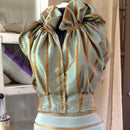Introduction: Interior Photo Technique
While photographing my laundry remodeling project last summer, I discovered that there are two situations that are extremely difficult to capture in digital photography: light fixtures, and indoor spaces with windows.
Recently, I wanted to photograph our dining room with a homemade chandelier turned on and a bright, snowy scene showing through a set of windows. I wanted detail in the room, in the light fixture, and in the outdoor snowy scene.
Unfortunately, it is not possible to have it all in a single shot, no matter how much special lighting you have. As you can see in photos 2, 3, 4, and 5, you will lose detail somewhere in the photo no matter what exposure you choose.
The solution to indoor/lighting photography?
1. Set the camera on a tripod.
2. Take three or four exactly placed photos at different exposures: one to capture the detail outside the window, one to capture detail in the light fixture, and one or two to capture detail in the rest of the room.
3. Mash all four photos in Photoshop.
Recently, I wanted to photograph our dining room with a homemade chandelier turned on and a bright, snowy scene showing through a set of windows. I wanted detail in the room, in the light fixture, and in the outdoor snowy scene.
Unfortunately, it is not possible to have it all in a single shot, no matter how much special lighting you have. As you can see in photos 2, 3, 4, and 5, you will lose detail somewhere in the photo no matter what exposure you choose.
The solution to indoor/lighting photography?
1. Set the camera on a tripod.
2. Take three or four exactly placed photos at different exposures: one to capture the detail outside the window, one to capture detail in the light fixture, and one or two to capture detail in the rest of the room.
3. Mash all four photos in Photoshop.
Step 1: How to Mash Different Exposures
To mash photos with different exposures, you'll need an image editing software that works in layers. Photoshop is one of several that do so, and it is the software used here.
Before you "mash," or combine, photos, be sure to make COPIES of the photos you wish to mash. DO NOT work with originals.
Next, layer the photos as follows from darkest to lightest.
1. Open the second darkest photo, select the entire photo with the selection tool and copy.
2. Open the darkest photo and paste the second darkest on top. The second darkest photo will appear above the darkest photo in the layers sidebar.
3. Repeat with second lightest and the lightest photos, pasting them on top of the darker photos. All photos will now appear in the layers sidebar stacked from darkest to lightest.
Before you "mash," or combine, photos, be sure to make COPIES of the photos you wish to mash. DO NOT work with originals.
Next, layer the photos as follows from darkest to lightest.
1. Open the second darkest photo, select the entire photo with the selection tool and copy.
2. Open the darkest photo and paste the second darkest on top. The second darkest photo will appear above the darkest photo in the layers sidebar.
3. Repeat with second lightest and the lightest photos, pasting them on top of the darker photos. All photos will now appear in the layers sidebar stacked from darkest to lightest.
Step 2: Correcting Exposure for Light Sources
To get the ideal exposure for all parts of the image, begin by hiding all but the darkest layer (click on the eye next to the layer you want to hide). Examine the darkest layer for anything you want to keep. Write it down. Do the same for each of the layers, then make all layers visible again.
Select the eraser tool and set the opacity to a low number (I work with an opacity of 15% or so).
Since you can only use the eraser tool with one layer at a time, select the top layer and erase through the washed out areas such as the windows and the light fixture.
Repeat with as many layers as you need to reveal the desired exposure.
In the mashup below, I erased three layers of windows and two layers of light fixtures to get the desired lighting balance.
Last step: crop and adjust the overall lighting and saturation as desired, and save. To save as a jpeg, click on the layers option and select "merge visible" layers, then save.
Select the eraser tool and set the opacity to a low number (I work with an opacity of 15% or so).
Since you can only use the eraser tool with one layer at a time, select the top layer and erase through the washed out areas such as the windows and the light fixture.
Repeat with as many layers as you need to reveal the desired exposure.
In the mashup below, I erased three layers of windows and two layers of light fixtures to get the desired lighting balance.
Last step: crop and adjust the overall lighting and saturation as desired, and save. To save as a jpeg, click on the layers option and select "merge visible" layers, then save.






